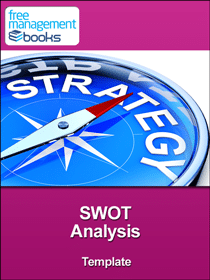
SWOT Analysis Template
This SWOT analysis template enables you to record the strengths, weaknesses, opportunities and threats. You can then prioritize and amalgamate the key issues for your organization helping you to evaluate your circumstance and guide you in developing a strategy.
A manager not only has to address customer expectations but also provide products and services that are better than the competition. It is up to the manager to take decisions and actions that will enable the organization to fill gaps in the market and stay ahead of the competition. Considerable research and brainstorming goes into the decision making process. One of the tools managers can use to make better decisions is a Strengths, Weaknesses, Opportunities and Threats (SWOT) analysis.
A SWOT analysis is merely a tool managers can use to justify their thoughts and ideas. What you can gain from the analysis are a number of ideas about how to tackle a problem or make the most of an opportunity. Hence, this tool can be used in the strategic planning process.
A SWOT analysis enables the manager to assess various aspects of the business in relation to the market conditions and level of competition prevalent. This is something extremely important to sustain growth and achieve the next level of success. Yet, there are some drawbacks of the SWOT analysis that make managers reluctant about using it. You can make your decision about whether or not you should use it based on its pros and cons.
Let’s have a look at the advantages and disadvantages of a SWOT analysis.
Objectivity
First and foremost, a SWOT analysis is completely objective and free from any bias. The reason for this is that the analysis addresses a particular problem and the issues related to it. The exercise is then used to figure out factors, both internal and external which may affect that particular issue. This approach remains the same regardless of whether the analysis is being done for product research or assessing the competition. The information you get is purely objective and free of noise.
Domain
A distinct advantage of a SWOT analysis is that it can be used to tackle a wide range of problems. Thus the problem domain for it is quite extensive. From launching a product to deliberating over a potential merger, a SWOT analysis can be carried out for virtually every major decision you have to make. So, once you have learned how to do this analysis, it makes finalizing the decision much easier.
Comprehensiveness
The third pro of a SWOT analysis is that it is quite comprehensive. It looks at the central issue from different angles, which are Strengths, Weaknesses, Opportunities and Threats. Therefore, you have a solid idea of what the outcome can be of your decisions. You will step into the arena well prepared and with a clear mind. Also, the analysis may help you uncover potential opportunities which you might have missed in the first place.
Simplicity
Perhaps the biggest advantage of a SWOT analysis is its simplicity. You don’t require any formal training or learning to be able to do it. All you need to have is knowledge of the business and the industry in which you operate. Simply speaking, it is so simple that anyone can do it. This relieves you of the burden of having to go through large amounts of data and complex processes.
These are the four best pros of a SWOT analysis. They are great reasons for you to try it for yourself. However, there are a couple of drawbacks which you need to know about before you decide to use it.
Equality
The first drawback is that each of the four factors is assigned an equal weight in the analysis. As a manager, you need to know which factor has more influence on your objective to take a decision. This is something missing from the analysis. So, you cannot know the extent to which each factor is going to affect the problem.
One-Dimensional
Along with the absence of any weighing factors, a SWOT analysis takes a one-dimensional approach. For instance, it is quite possible that the same factor can be viewed both as strength and weakness but the analysis won’t show you that. You may assume that the factor will help solve the problem but may have no idea that it could actually make things worse.
Subjectivity
The analysis is objective but is based on information which is subjective. The analysis can only use the data used in it, which can be decided by one or two people only. What those people think about the problem will be reflected in the outcome. It is also possible that they may overlook something important.
As you can see, there are drawbacks to using a SWOT analysis. This is the only reason why it is merely a tool you can use for decision making. It will provide ideas and not much else. Yet, that doesn’t mean it is not effective. The decision to use it lies with you.
